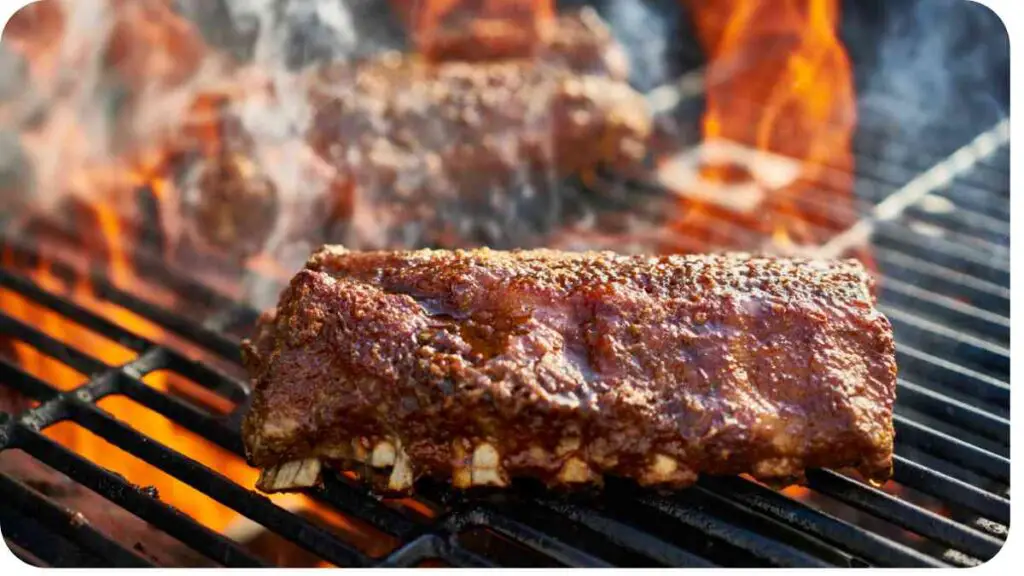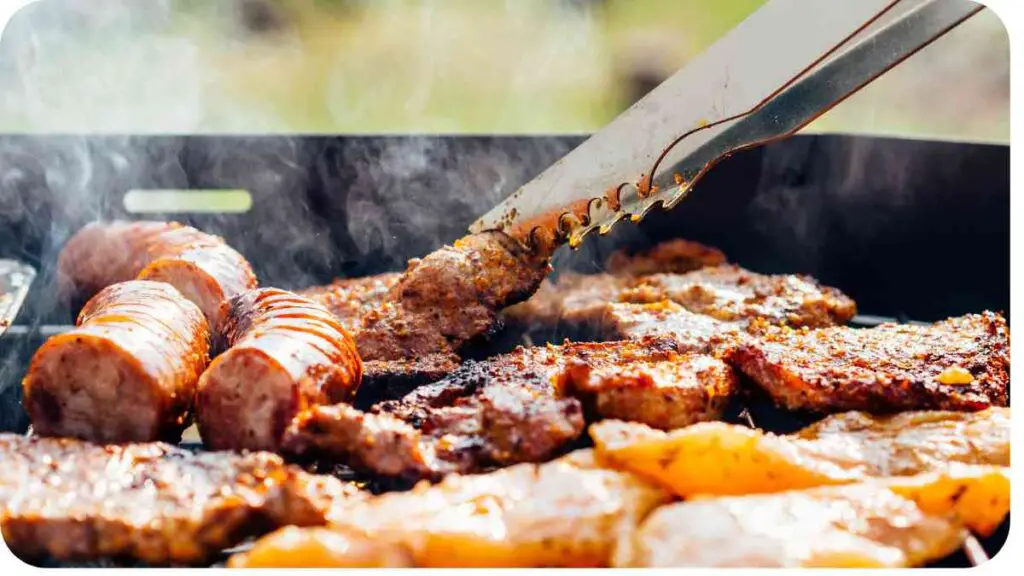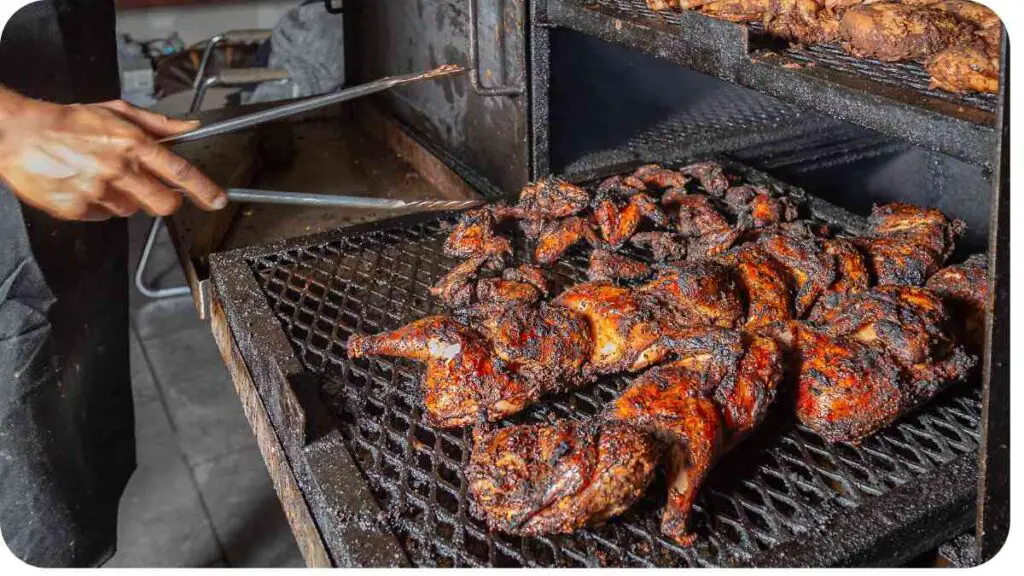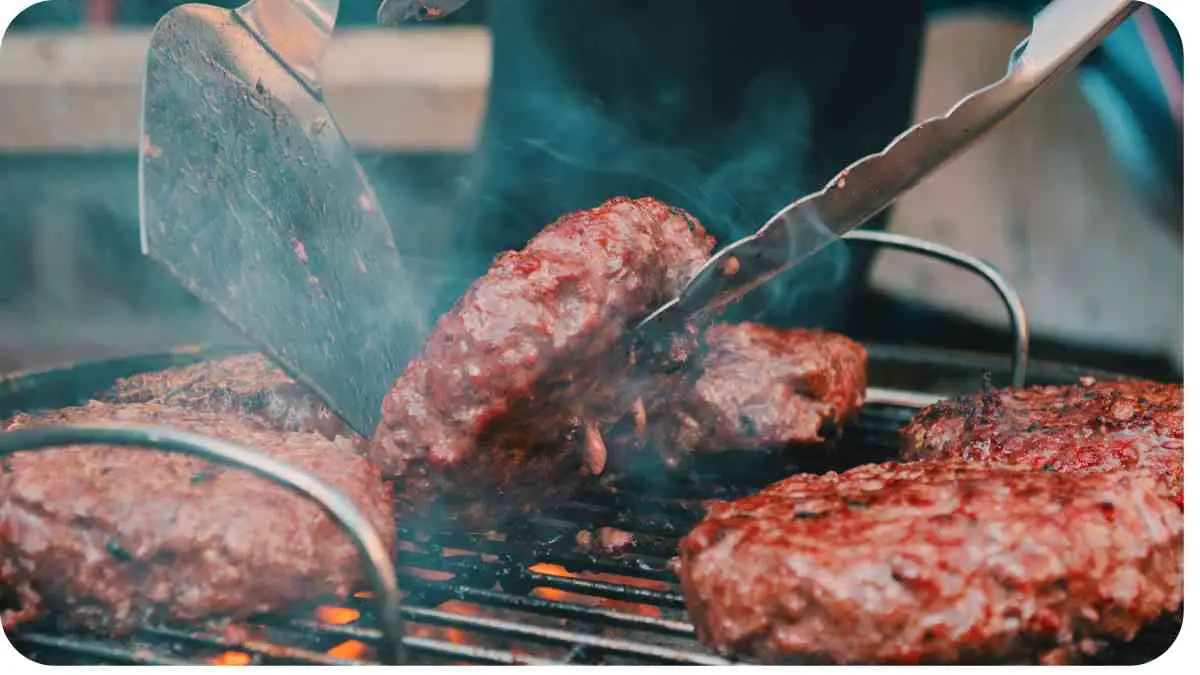Grilling is a beloved pastime for many, but concerns about the potential health risks associated with grilled meats can dampen the enjoyment. However, fear not! With the right knowledge and techniques, you can indulge in delicious grilled fare without compromising your health. In this comprehensive guide, we’ll explore the best practices for grilling meat that minimize the risk of cancer while maximizing flavor and enjoyment.
| Takeaways |
|---|
| Choose lean cuts of meat and trim excess fat to reduce flare-ups and minimize harmful compounds. |
| Marinate meat before grilling using ingredients like vinegar, citrus juice, and herbs to reduce cancer risk and enhance flavor. |
| Cook meat indirectly to avoid direct flame contact and lower the risk of charring and carcinogen formation. |
| Monitor cooking temperatures with a meat thermometer to ensure safe and proper cooking. |
| Rest grilled meat before serving to allow juices to redistribute, resulting in a juicier and more flavorful outcome. |
| Incorporate safe grilling practices, such as avoiding sugary marinades and excessive charring, to minimize cancer risk while still enjoying grilled foods. |
2. Understanding the Risks
Before we delve into the specifics of safe grilling, it’s essential to understand why certain grilling methods can pose risks to your health. When meat is cooked at high temperatures, especially over an open flame, it can lead to the formation of harmful compounds such as heterocyclic amines (HCAs) and polycyclic aromatic hydrocarbons (PAHs). These compounds have been linked to an increased risk of cancer, particularly colorectal and prostate cancer.
Root rot can devastate your tomato plants, but with proper care, you can ensure healthy growth. Learn essential tips and tricks to prevent root rot and promote thriving tomatoes in your garden.
Table: Common Health Risks Associated with Grilled Meat
| Health Risk | Description |
|---|---|
| Formation of HCAs and PAHs | High-temperature cooking methods can lead to the production of carcinogenic compounds in grilled meat. |
| Increased Cancer Risk | Consumption of foods containing HCAs and PAHs has been linked to an elevated risk of certain cancers. |
3. Choosing the Right Meat

The type of meat you choose can significantly impact the formation of harmful compounds during grilling. Opting for leaner cuts of meat and trimming excess fat can reduce flare-ups and minimize the production of HCAs and PAHs. Additionally, selecting smaller cuts or thinner slices can decrease cooking time, which helps limit exposure to high temperatures.
Say goodbye to pesticide burn woes! Discover effective organic remedies to rescue your garden from damage caused by pesticides. Explore natural solutions to maintain a healthy and vibrant garden environment without harming beneficial insects.
Table: Best Meat Choices for Grilling
| Meat | Description |
|---|---|
| Lean Cuts | Choose lean cuts of meat with minimal visible fat to reduce flare-ups. |
| Poultry | Skinless chicken breasts and turkey burgers are lean options for healthier grilling. |
| Fish and Seafood | Salmon, tuna, and shrimp are excellent alternatives with lower cancer risks. |
| Plant-based Alternatives | Consider grilling vegetables, tofu, or tempeh for a meatless option. |
4. Preparing Your Grill
Properly preparing your grill before cooking can make a significant difference in both flavor and safety. Cleaning the grates thoroughly and removing any leftover food particles can help prevent the buildup of carcinogens. Additionally, consider using a grill brush to scrape away any residue and preheat the grill to the appropriate temperature before cooking.
Table: Grill Preparation Tips
| Preparation Step | Description |
|---|---|
| Clean the Grill Grates | Use a wire brush to remove debris and residue from the grates. |
| Preheat the Grill | Allow the grill to preheat for at least 10-15 minutes before cooking. |
| Oil the Grates | Lightly oil the grates before cooking to prevent sticking and flare-ups. |
| Use a Grill Mat | Consider using a grill mat or foil to create a barrier between the food and flames. |
Let’s continue exploring the best practices for safe and flavorful grilling without increasing cancer risks.
5. Cooking Techniques
The way you cook your meat can greatly influence its safety and flavor. Employing indirect grilling methods, such as using a grill with a lid or creating a two-zone fire, can help reduce exposure to direct flames and lower the risk of charring. Additionally, avoiding prolonged cooking times and flipping the meat regularly can ensure even cooking without overexposure to high temperatures.
Patchy lawn growth can be frustrating, but fear not! Resolve Scotts Turf Builder issues with expert tips. Learn how to address common problems and achieve lush, uniform grass for a beautiful outdoor space.
Table: Recommended Cooking Techniques
| Technique | Description |
|---|---|
| Indirect Grilling | Utilize a grill with a lid or create a two-zone fire to minimize direct flame contact. |
| Low and Slow Cooking | Opt for lower cooking temperatures and longer cooking times to reduce the formation of harmful compounds. |
| Regular Flipping | Flip the meat regularly to ensure even cooking and prevent charring. |
| Use a Meat Thermometer | Monitor internal temperatures to ensure meat is cooked to the desired level of doneness. |
6. Marinating for Safety and Flavor
Marinating meat before grilling not only enhances its flavor but can also help mitigate the formation of carcinogenic compounds. Ingredients such as acidic liquids (e.g., vinegar, citrus juice), herbs, and spices contain antioxidants that can counteract the effects of HCAs and PAHs. Aim to marinate meat for at least 30 minutes to allow the flavors to penetrate and create a protective barrier during cooking.
Table: Marinade Ingredients for Safety and Flavor
| Ingredient | Description |
|---|---|
| Vinegar or Citrus Juice | Adds acidity to the marinade, which can help reduce the formation of harmful compounds. |
| Olive Oil | Provides flavor and helps distribute seasonings evenly while acting as a barrier during cooking. |
| Garlic and Herbs | Adds depth of flavor and contains antioxidants that can counteract the effects of HCAs and PAHs. |
| Soy Sauce | Adds umami and depth to the marinade while providing a rich color to grilled meats. |
7. Avoiding Direct Flame Contact

Direct contact with flames can increase the risk of charring and the formation of harmful compounds on your grilled meat. To avoid this, position your meat away from direct flames or use a grill with adjustable grates to control the distance between the food and the heat source. Additionally, consider using a drip tray to catch excess fat and juices, reducing flare-ups and minimizing the production of carcinogens.
Avoid overfeeding your plants with these essential Miracle-Gro watering mistakes. Discover the dos and don’ts of watering to ensure optimal growth and health for your garden. Keep your plants thriving with proper watering techniques.
Table: Tips for Avoiding Direct Flame Contact
| Tip | Description |
|---|---|
| Position Meat Away from Direct Flames | Place the meat on the grill away from the hottest part of the fire to minimize charring. |
| Use Adjustable Grates | Adjust the height of the grates to control the distance between the food and the heat source. |
| Employ Indirect Grilling Techniques | Utilize indirect grilling methods to reduce direct flame contact and lower the risk of charring. |
| Use a Drip Tray | Place a drip tray beneath the meat to catch excess fat and juices, reducing flare-ups. |
8. Using the Right Fuel
The type of fuel you use in your grill can impact both the flavor of your food and the formation of harmful compounds. Opt for natural hardwood charcoal or lump charcoal instead of briquettes, which may contain additives that can produce undesirable flavors and increase carcinogen formation. If you prefer gas grilling, choose propane or natural gas over charcoal for cleaner burning and fewer emissions.
Table: Comparison of Grill Fuels
| Grill Fuel | Description |
|---|---|
| Natural Hardwood Charcoal | Provides a smoky flavor and cleaner burning compared to briquettes. |
| Lump Charcoal | Made from pure wood, lump charcoal burns hotter and produces less ash than briquettes. |
| Propane | Offers convenience and precise temperature control with cleaner burning compared to charcoal. |
| Natural Gas | Connected directly to your home’s gas line, natural gas grills are cost-effective and efficient. |
9. Adding Flavor Safely
While adding flavor to your grilled meat is essential for a delicious outcome, it’s crucial to do so safely. Avoid using sugary marinades or barbecue sauces, as they can char and increase the formation of harmful compounds. Instead, opt for dry rubs or marinades with minimal sugar content. Additionally, consider adding flavor through herbs, spices, and aromatics, which can enhance the taste without posing additional health risks.
Table: Safe Flavoring Options for Grilled Meat
| Flavoring Option | Description |
|---|---|
| Dry Rubs | Blend of herbs, spices, and seasonings applied to the surface of the meat for flavor enhancement. |
| Herb and Spice Rubs | Mixtures of dried herbs and spices that add depth of flavor without increasing cancer risks. |
| Aromatics | Garlic, onions, ginger, and other aromatics provide flavor without the need for sugary sauces. |
| Low-Sugar Marinades | Marinate meat in mixtures containing minimal sugar to avoid charring and excess caramelization. |
10. Monitoring Cooking Temperatures
Maintaining proper cooking temperatures is essential for both food safety and reducing the formation of harmful compounds. Invest in a quality meat thermometer to ensure that your meat reaches the appropriate internal temperature for safe consumption. Different types of meat have varying recommended cooking temperatures, so refer to a reliable cooking guide for specific guidelines.
Understanding how underground septic tanks function is crucial for homeowners. Dive into the workings of residential yards to ensure proper maintenance and avoid costly issues. Gain insights into septic tank operation and make informed decisions for your property’s sewage system.
Table: Recommended Cooking Temperatures for Various Meats
| Meat | Recommended Internal Temperature (°F) |
|---|---|
| Beef (steaks, roasts) | 145 (medium-rare) to 160 (well-done) |
| Pork | 145 (medium-rare) to 160 (well-done) |
| Chicken | 165 |
| Fish | 145 |
Maintaining these temperatures ensures that your grilled meat is not only safe to eat but also cooked to perfection. Let’s continue to explore more tips for safe and flavorful grilling.
11. Flipping and Turning
Properly flipping and turning your meat during the grilling process can help ensure even cooking and minimize the formation of harmful compounds. Avoid leaving meat in one position for too long, as this can lead to uneven cooking and increased charring. Instead, flip and rotate the meat periodically to promote uniform browning and reduce the risk of overexposure to high heat.
Table: Tips for Flipping and Turning Meat
| Tip | Description |
|---|---|
| Use Tongs or a Spatula | Flip meat using tongs or a spatula to prevent puncturing and losing juices. |
| Rotate Meat Regularly | Rotate the meat periodically to promote even cooking and prevent charring. |
| Avoid Excessive Flipping | Limit flipping to avoid disrupting the cooking process and maintain juiciness. |
| Adjust Cooking Time as Needed | Monitor the meat’s progress and adjust cooking time accordingly for optimal results. |
12. Resting Your Meat
Allowing your grilled meat to rest before slicing and serving is a crucial step often overlooked by many home cooks. Resting allows the juices to redistribute throughout the meat, resulting in a more tender and flavorful final product. Cover the meat loosely with foil and let it rest for a few minutes before cutting to ensure optimal texture and juiciness.
Table: Importance of Resting Grilled Meat
| Benefit | Description |
|---|---|
| Juiciness Preservation | Resting allows juices to redistribute, preventing them from flowing out when the meat is sliced. |
| Enhanced Flavor | Resting allows flavors to meld and develop, resulting in a more flavorful end product. |
| Tender Texture | Resting helps relax the muscle fibers, resulting in a more tender and enjoyable eating experience. |
| Temperature Equalization | Resting allows the meat’s internal temperature to stabilize, ensuring even doneness throughout. |
Taking the time to rest your grilled meat can make a significant difference in its taste and texture. Let’s explore more essential tips for safe and delicious grilling practices.
13. Avoiding Charred Bits

While a bit of char on grilled meat can add flavor, excessive charring can increase the formation of harmful compounds. To avoid charred bits, avoid cooking meat directly over high flames for extended periods. Additionally, trim off any excessively charred portions before serving. Opt for slower cooking methods and lower heat settings to achieve a golden brown exterior without excessive charring.
Table: Tips for Avoiding Charred Bits
| Tip | Description |
|---|---|
| Use Indirect Heat | Cook meat away from direct flames to reduce the risk of excessive charring. |
| Trim Excessively Charred Portions | Remove charred bits before serving to minimize exposure to harmful compounds. |
| Monitor Heat Levels | Adjust heat settings to maintain a moderate temperature and prevent charring. |
| Consider Precooking | Precooking meat partially before grilling can reduce cooking time and minimize charring. |
14. Conclusion
Grilling meat is a popular culinary technique enjoyed by many, but it’s essential to do so safely to minimize health risks. By following the tips outlined in this guide, you can enjoy delicious grilled fare without compromising your health. From choosing the right cuts of meat to employing safe cooking techniques and monitoring temperatures, there are many strategies to grill meat safely and deliciously.
Remember, moderation is key. While grilled meat can be a flavorful addition to your diet, it’s essential to balance it with plenty of fruits, vegetables, and other nutritious foods. By incorporating these tips into your grilling routine, you can enjoy the best of both worlds tasty, succulent grilled meat and peace of mind knowing you’re cooking safely.
Further Reading
- Grilling Meat Raises Cancer Risk: Here Are Ways to Lower It: Learn more about the connection between grilling meat and cancer risk, and discover effective strategies for reducing this risk while still enjoying grilled foods.
- Practicing Safe Grilling Can Reduce Cancer Risk, Experts Say: Explore expert advice on safe grilling practices to minimize cancer risk and ensure healthier outdoor cooking.
- How to Cook Meat and Keep Your Cancer Risk Low: Discover practical tips for cooking meat in ways that reduce cancer risk, as recommended by cancer prevention experts at MD Anderson Cancer Center.
FAQs
Is grilling meat really linked to cancer risk?
Yes, grilling meat at high temperatures can lead to the formation of carcinogenic compounds, such as heterocyclic amines (HCAs) and polycyclic aromatic hydrocarbons (PAHs), which may increase cancer risk.
How can I reduce the formation of harmful compounds when grilling meat?
You can reduce the formation of harmful compounds by choosing lean cuts of meat, marinating meat before grilling, avoiding direct flame contact, and cooking at lower temperatures.
Are there specific types of meat that are safer to grill?
Lean cuts of meat, poultry without skin, fish, and seafood are generally considered safer options for grilling, as they tend to produce fewer harmful compounds when cooked at high temperatures.
Should I be concerned about charring on grilled meat?
Excessive charring on grilled meat can increase the formation of carcinogenic compounds. It’s best to avoid overcooking and trim off any excessively charred portions before consuming.
How important is it to monitor cooking temperatures when grilling meat?
Monitoring cooking temperatures is crucial for ensuring that meat is cooked to the proper level of doneness while minimizing the formation of harmful compounds. Using a meat thermometer can help you achieve safe cooking temperatures.

I am Hellen James, a landscape architect. For many years I have written about landscaping for various publications; however, recently decided to focus my writing on personal experience as a profession.

